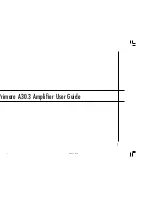
3
Connect a footswitch to ampli
fi
er to remotely engage OVERDRIVE.
Three Fender footswitches will work (shown at right with part numbers;
Economy footswitch model is included with Rumble 800 head), or any
generic single-button latching-type footswitch will work. Contact a local
Fender dealer to purchase a Fender footswitch of choice.
During footswitch use, front-panel OVERDRIVE switch remains functional.
Note that normal front-panel switch position (in=ON, out=OFF)
can
become reversed depending on footswitch status
. Overdrive LED status
on front panel will
always
be correct, but indicator light on an LED
footswitch (such as model 0994052000 at right) may display incorrectly
(i.e., LED is o
ff
when OVERDRIVE is on) depending on front-panel switch
status. When using an LED footswitch, keep front-panel OVERDRIVE
switch in OUT position to ensure correct display status on footswitch LED.
ECONOMY FOOTSWITCH (Included, PN 0994049000):
Basic black single-button on/o
ff
footswitch.
VINTAGE FOOTSWITCH (Optional, PN 0994054000):
Chrome single-button on/o
ff
footswitch.
LED FOOTSWITCH (Optional, PN 0994052000):
Contemporary single-button on/o
ff
footswitch with LED
indicator. NOTE: For correct operation of footswitch LED,
overdrive e
ff
ect must be switched o
ff
before connecting this
footswitch.
FOOTSWITCHES
The Rumble 800 amp head is lightweight and compact, which makes
it easy to transport and set up. When placed on top of a non-matching
speaker enclosure, however, it becomes subject to the extreme
vibrations it’s capable of producing at high volume. Matching Rumble
speaker enclosures feature a magnetic locking system to properly
secure a Rumble amp head in place during normal operation. Simply
set your Rumble amp head into the foot cups on top of the Rumble
speaker enclosure to lock it in place.
NOTE:
The magnetic locking system should not be used to secure a
Rumble head amplifier during transportation—avoid potential damage
by first detaching the head from the Rumble speaker enclosure. Please
use caution when using a Rumble amp head on top of any other non-
matching speaker enclosure.
RUMBLE AMP HEADS WITH RUMBLE SPEAKER ENCLOSURES
The Rumble 800 head uses a class-D power ampli
fi
er with thermal and
short circuit protection. In the event of a short circuit, the ampli
fi
er will
temporarily mute (no sound from speakers; power indicator illuminates
solid amber) and resume normal operation when the fault is removed
(power indicator returns to solid red).
For increased thermal performance, the Rumble 800 head has variable-
speed fan cooling that starts at low speed and increases as ampli
fi
er
temperature rises with playing use.
Leave at least 6” clearance between the ampli
fi
er vents and other
objects. If the ampli
fi
er vents are blocked or if the amp is used in an
extremely hot environment, the amp may overheat and trigger thermal
protection, causing temporary speaker muting (power indicator
illuminates solid amber). Normal operation will automatically resume
after the temperature cools to a level within operating range (power
indicator returns to solid red).
Under the most severe operating conditions, the amp can overheat
to the point of interrupting power, resulting in no sound from the
speakers. In this unlikely event, normal operation will automatically
resume after the temperature cools to a level within operating range.
THERMAL PERFORMANCE AND PROTECTION
EN
GL
ISH
IMPORTANT NOTE:
True impedance for any speaker enclosure is
frequency-dependent and may dip below nominal impedance rating
(i.e., 4
Ω
). Some cabinets or combinations thereof may stress the
amplifier and produce unwanted noise under peak conditions if actual
impedance is too low. Setting IMPEDANCE SWITCH to 2
Ω
may eliminate
such noise with minimal volume loss, even if rated impedance is 4
Ω
or
higher.
The Rumble 800 head’s high-power class “D” ampli
fi
er operates in bridge
mode, meaning that voltage is present in both terminals (+) and (-).
Use caution when connecting a speaker cable to the External Speaker
output on the rear panel—
never
let the tip (+) or sleeve (-) of a speaker
cable (
see illustration below
) contact the amp’s metal chassis or any other
earth-grounded electrical equipment (i.e., audio mixers and other sound
reinforcement devices). A speaker cable plugged into the amp’s External
Speaker output should be connected
only
to another speaker cabinet.
Use caution when connecting 1/4” speaker cables with non-insulated
(bare metal) plugs—always make speaker cable connections with the
amp’s power turned o
ff
.
M. LINE OUT:
Balanced output to connect to external devices such
as PA systems and recording consoles. Pressing the GND LIFT
button IN may eliminate hum or buzz resulting from connection to
improperly grounded equipment. Select PRE for direct una
ff
ected
signal; select POST for fully processed signal (except MASTER).
Speaker cabinet connection not required for silent recording
applications.
N. FOOTSWITCH:
Allows remote switching of OVERDRIVE section. See
“Footswitches” section below for details.
O. AUX IN:
Connect external audio player here. Adjust volume/tone
of aux signal at its source (amp MASTER volume doesn’t a
ff
ect
volume of external source). Note that using earth-grounded audio
equipment (such as a laptop with a connected power supply) may
result in unwanted noise/hum.
P. PHONES:
Plug in stereo headphones here (16 ohms minimum
impedance). Speaker output is automatically muted.
Q. EFFECTS LOOP:
Connect SEND to input of outboard e
ff
ects
devices (delay, chorus, etc.) and output of e
ff
ects devices to
RETURN. Placing e
ff
ects in EFFECTS LOOP (instead of between bass
and INPUT) will reduce the amount of noise and tone degradation
caused by e
ff
ects pedals. For multi-amp con
fi
guration, connect
primary amp SEND to secondary amp RETURN. Instrument is
connected to primary amp; preamp controls will adjust tone for
both units (secondary unit preamp controls are bypassed). Use
MASTER volume on both amps to independently control loudness
of each.
Insulation
( + )
( - )




































